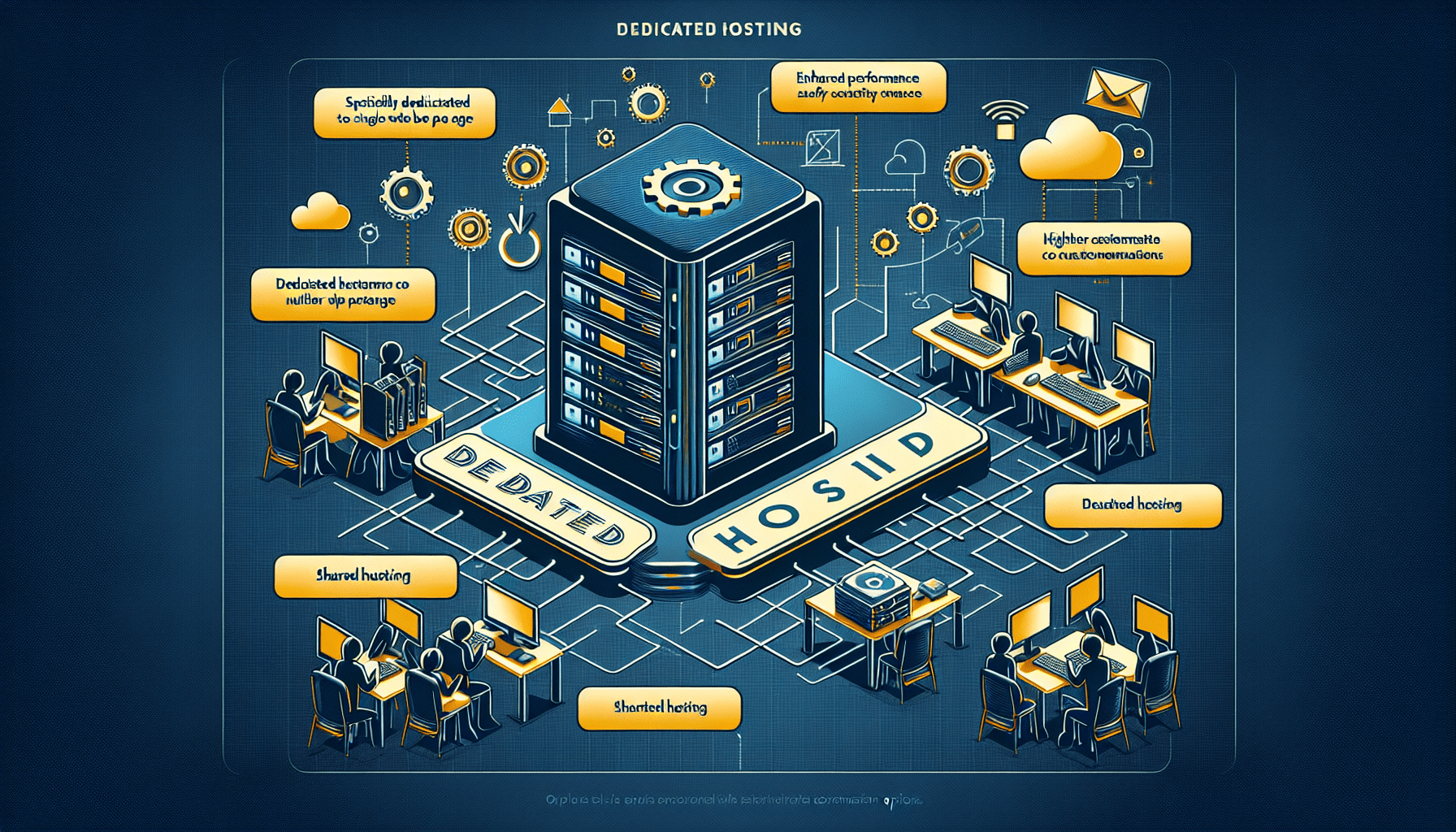Do you ever find yourself waiting impatiently for a website to load? We’ve all been there. The good news is, there’s a solution to this frustrating issue: optimizing database performance. In this article, we’ll explore the importance of optimizing your database for improved website speed. By making a few simple adjustments, you can not only enhance the user experience but also boost your website’s overall performance. So let’s dive in and discover the key strategies to optimize your database and provide a lightning-fast website for your visitors to enjoy.
Choosing the Right Database
Understanding different types of databases
When it comes to choosing the right database for your application, it’s important to understand the different types available. There are several popular options, including relational databases, NoSQL databases, and in-memory databases.
Relational databases, such as MySQL and PostgreSQL, have been around for decades and are known for their structured approach to data storage. They use tables with predefined columns and rows to organize data in a consistent manner. Relational databases are great for applications that require complex queries and transactions.
On the other hand, NoSQL databases, like MongoDB and Cassandra, offer a more flexible approach to data storage. They are designed to handle large amounts of unstructured or semi-structured data, making them ideal for applications with rapidly changing data models or high scalability requirements.
Lastly, in-memory databases, such as Redis and Memcached, store data in memory rather than on disk. This allows for incredibly fast read and write operations, making them well-suited for applications that require real-time data processing or caching.
Considerations for selecting a database
When selecting a database, you should consider several factors, including the scalability requirements of your application, the complexity of your data model, and the specific features and performance characteristics offered by each database type.
Scalability is an important consideration because your application’s database needs may increase over time. If you expect a large number of users or data growth, a database that supports horizontal scaling, such as a NoSQL database, may be a better choice.
Additionally, the complexity of your data model should be considered. If you have a highly structured data model with complex relationships, a relational database might be the best fit. However, if your data is more flexible and evolving, a NoSQL database may provide greater flexibility.
Finally, it’s important to consider the specific features and performance characteristics offered by each database type. Some databases excel in certain areas, such as transaction support or full-text searching. Evaluate your application’s requirements and choose a database that aligns with those needs.
Database Indexing
Understanding indexing
Indexing is a crucial aspect of database performance optimization. Simply put, an index is a data structure that improves the speed of data retrieval operations on a database table. By creating an index on one or more columns, the database can quickly locate the required data, reducing the amount of time it takes to execute queries.
Indexes work by creating a sorted representation of the indexed columns, which allows the database to perform binary searches rather than scanning the entire table. This significantly reduces the time required to locate specific rows.
Identifying key fields for indexing
To optimize database performance, it is important to identify the key fields that should be indexed. These are the fields that are frequently used in queries or have high selectivity, meaning they have a wide range of unique values.
To determine which fields to index, analyze your application’s query patterns and identify the columns that are most commonly used in WHERE clauses or joins. These columns are good candidates for indexing as they can greatly improve query performance.
It’s also important to consider the selectivity of the columns. If a column has a limited number of unique values, indexing may not provide significant performance improvements. In such cases, it may be more effective to index a combination of columns to create composite indexes.
Implementing indexing strategies
Once you have identified the key fields for indexing, you can implement indexing strategies to optimize query performance. The most common indexing strategies include creating indexes on single columns, creating composite indexes on multiple columns, and using covering indexes.
Single column indexes are useful when queries frequently filter or sort data based on a specific column. Composite indexes, on the other hand, are beneficial when queries involve multiple columns. By creating an index on a combination of columns, the database can efficiently locate the required rows without having to perform additional lookups.
Covering indexes are a powerful optimization technique that can significantly improve query performance. These indexes contain all the columns necessary to satisfy a query, eliminating the need for the database to access the actual table data. This can greatly reduce disk I/O and improve query execution time.
Database Query Optimization
Analyzing and optimizing queries
Analyzing and optimizing queries is another important aspect of database performance optimization. By understanding how queries are executed and identifying areas for improvement, you can significantly enhance the overall performance of your application.
Start by analyzing the execution plans of your queries. Execution plans outline the steps the database takes to execute a query and provide valuable insights into where bottlenecks may exist. Look for areas where the database is performing costly operations, such as full table scans or inefficient join operations.
Once you have identified areas for improvement, you can optimize the queries by rewriting them or modifying the database schema. Techniques such as adding appropriate indexes, reordering join operations, or utilizing query hints can improve query performance.
Using query analyzers and profilers
Query analyzers and profilers are powerful tools that can help identify performance issues in your database queries. These tools analyze query execution plans and provide detailed information about query performance, including the number of reads and writes, the time taken for each operation, and the resources utilized.
By using these tools, you can pinpoint specific queries that are causing performance bottlenecks and take appropriate action. You can also identify slow-performing queries and make necessary optimizations to improve overall performance.
Identifying and resolving performance bottlenecks in queries
Identifying and resolving performance bottlenecks in queries is crucial for improving database performance. Common performance bottlenecks include lack of appropriate indexes, inefficient query execution plans, or excessive data processing.
To address these bottlenecks, consider creating necessary indexes on frequently accessed columns and optimizing the query execution plans. Additionally, you can explore techniques like query caching or materialized views to further improve query performance.
Remember that performance optimization is an iterative process, and it’s essential to regularly monitor and analyze your queries to identify new bottlenecks as your application evolves.
Caching Strategies
Understanding caching and its benefits
Caching is a technique used to store frequently accessed data in memory for quick retrieval. By storing data closer to the application, caching helps reduce the load on the database and improves overall system performance.
Caching can provide significant benefits, such as faster response times, improved scalability, and reduced resource consumption. By eliminating the need to fetch frequently accessed data from the database, you can significantly improve website speed and user experience.
Implementing caching mechanisms
To implement caching in your application, you can leverage caching mechanisms provided by your programming language or framework. This typically involves using key-value stores, such as Redis or Memcached, to store cached data in memory.
When implementing caching, consider the expiration policy of cached data. You want to strike a balance between freshness and performance. Data that is frequently updated may require a shorter expiration time, whereas relatively static data can be cached for longer periods.
It’s also important to consider how to handle cache invalidation. When the underlying data changes, you need to ensure that the corresponding cached data is updated or invalidated to prevent serving stale information.
Using caching frameworks
In addition to low-level caching mechanisms, there are also caching frameworks available that simplify the process of implementing caching in your application. These frameworks provide higher-level abstractions and often include features like automatic cache invalidation and advanced caching strategies.
Frameworks such as MemcacheDjango, Spring Cache, or Symfony Cache can greatly simplify the integration of caching into your application. They provide pre-built components and APIs that make it easy to cache data and control caching behavior.
By leveraging caching frameworks, you can accelerate the implementation of caching strategies and achieve improved website speed with minimal effort.
Database Schema Optimization
Denormalization and normalization techniques
Database schema optimization involves designing the structure and organization of your database to minimize redundancies and improve performance. One approach is denormalization, which involves combining or duplicating data to simplify queries and improve read performance.
Denormalization reduces the need for complex joins, which can be resource-intensive, by storing related data together in a single table. This can lead to improved read performance, especially for queries that involve retrieving data from multiple tables.
Conversely, normalization is a technique that aims to eliminate redundancies and ensure data integrity by breaking down data into logical units and storing it in separate tables. Normalization can lead to better data consistency and update performance, but it may result in increased complexity and reduced read performance.
Optimizing database schema design
Optimizing database schema design involves careful consideration of the relationships between tables and the types of queries that will be performed against the database.
Start by analyzing your application’s query patterns and identifying the most frequently used tables and relationships. This will help you determine which tables should be denormalized or normalized to achieve optimal performance.
Consider creating indexes on frequently accessed columns and maintaining referential integrity constraints to enforce consistency and data integrity. Properly structuring and organizing your database schema can greatly improve query performance and overall database efficiency.
Avoiding redundant or excessive data
To optimize database performance, it’s important to avoid redundant or excessive data in your database schema. Redundancies can lead to increased storage requirements, slower write performance, and data inconsistencies.
Carefully analyze your data model and ensure that each piece of data is stored in only one place. Avoid duplicating data across multiple tables or adding unnecessary columns. By eliminating redundancies, you can reduce the size of your database and improve overall performance.
Similarly, avoid excessive data by only storing the necessary information for each record. Consider removing any unused or unnecessary fields. This can improve query performance by reducing the amount of data that needs to be read from disk.
Database Connection Pooling
Understanding connection pooling
Connection pooling is a technique used to manage a pool of database connections that can be reused by multiple clients. Instead of creating a new connection for each client request, connection pooling allows clients to borrow a connection from the pool, use it, and then return it for reuse.
Connection pooling can significantly improve database performance by reducing the overhead of establishing a new connection for each client request. It helps minimize the time spent on connection establishment and teardown and improves the overall efficiency of your application.
Configuring connection pool settings
When configuring connection pool settings, it’s important to consider factors such as the maximum number of connections, connection timeouts, and idle connection management.
The maximum number of connections determines the total number of connections that can be created in the connection pool. Setting an appropriate maximum number ensures that your application can efficiently handle concurrent requests without overwhelming the database server.
Connection timeouts define the maximum amount of time a connection can remain idle before it is closed and returned to the pool. Idle connection management ensures that connections are released back to the pool when they are no longer needed, freeing up resources for other clients.
By fine-tuning these settings based on the expected workload and database server capacity, you can optimize connection pooling and improve overall application performance.
Implementing connection pooling in your application
To implement connection pooling in your application, you can utilize connection pool libraries or frameworks provided by your programming language or database driver. These libraries handle the creation, management, and pooling of database connections, making it easy to integrate connection pooling into your application.
Popular connection pool libraries include HikariCP for Java, psycopg2 for Python, and pyodbc for .NET. These libraries provide advanced connection management features and allow you to customize connection pool settings to match your application’s requirements.
By implementing connection pooling, you can efficiently manage database connections, reduce connection overhead, and improve the overall scalability and performance of your application.
Optimizing Database Configuration
Performance tuning database parameters
Optimizing database configuration involves tuning various parameters and settings to maximize the performance of your database server.
Start by analyzing your application’s workload and understand the specific requirements and characteristics of your database. This will help you identify parameters that need adjustment.
Database parameters that are commonly tuned include memory allocation, disk I/O settings, parallelism settings, and query execution thresholds. Adjusting these parameters based on your application’s workload and hardware capabilities can greatly improve database performance.
Configuring memory allocation
Memory allocation plays a critical role in the performance of your database server. The amount of memory allocated to the database cache and query execution can significantly impact query response times.
To optimize memory allocation, consider adjusting parameters such as shared_buffers, work_mem, and effective_cache_size. These parameters control the amount of memory allocated to various aspects of the database, including query execution, caching, and sorting.
By carefully configuring memory allocation, you can ensure that the database has enough memory to perform its operations efficiently and minimize disk I/O, resulting in improved database performance.
Managing disk I/O and storage
Efficient disk I/O and storage management are crucial for optimal database performance. By minimizing disk I/O and ensuring effective use of storage resources, you can reduce latency and improve the overall responsiveness of your database.
To optimize disk I/O, consider using techniques such as RAID configurations or solid-state drives (SSDs) for improved read and write performance. Additionally, strategically placing database files on separate disks or partitions can help distribute I/O load and minimize contention.
Optimizing storage also involves regular maintenance tasks such as cleaning up unused objects, reclaiming wasted space, and performing periodic vacuuming or reindexing. These tasks ensure that your database remains efficient and avoids unnecessary overhead.
Database Server Optimization
Optimizing hardware resources
Optimizing hardware resources is essential for achieving optimal database performance. By ensuring that your database server has sufficient CPU, memory, and disk resources, you can eliminate hardware-related bottlenecks and maximize system efficiency.
Consider scaling your hardware resources based on your application’s workload and growth projections. Increasing the number of CPU cores, allocating more memory, or utilizing fast storage technologies can greatly improve database server performance.
Additionally, ensure that your database server is properly configured to take advantage of hardware optimizations. This may involve enabling features like multithreading, parallel query execution, or disk write caching. Consult your database vendor’s documentation for specific hardware optimization recommendations.
Configuring server settings for performance
In addition to optimizing hardware resources, it’s important to configure server settings for optimal performance. Server settings such as maximum connections, query timeouts, and network buffers can greatly impact the overall performance and responsiveness of your database server.
Adjusting the maximum number of connections to match your application’s workload ensures that your database can handle concurrent requests without becoming overwhelmed. Setting appropriate query timeouts and network buffers helps prevent query delays caused by slow network connections.
Consider monitoring and tuning other server settings, such as the blocking threshold, memory allocation for various components, or query plan cache size, to further optimize your database server’s performance.
Monitoring and analyzing server metrics
Regular monitoring and analysis of server metrics is critical for identifying performance issues and optimizing your database server.
Monitor key metrics such as CPU usage, memory utilization, disk I/O, and network latency to identify bottlenecks or resource constraints. Analyze trends and patterns in these metrics to proactively address performance issues before they impact the responsiveness of your database server.
Leverage monitoring tools and dashboards provided by your database vendor, or use third-party monitoring solutions, to collect and visualize server metrics. These tools often provide real-time or historical data, alerts, and performance tuning recommendations, making it easier to optimize your database server.
Database Maintenance and Optimization
Regularly backing up and optimizing databases
Regularly backing up and optimizing your databases is essential for data protection and maintaining optimal performance.
Implement a regular backup strategy that includes full, incremental, or differential backups based on your data sensitivity and recovery requirements. Schedule backups in a way that minimizes impact on database performance and validate the integrity of backups to ensure they can be restored if needed.
In addition to backups, regularly optimize your databases to eliminate fragmentation, rebuild indexes, and update query statistics. These maintenance tasks improve the overall performance and efficiency of your database by removing unnecessary overhead and improving data access patterns.
Automate backup and optimization tasks using database maintenance plans or scheduled scripts to ensure that they are performed consistently and to minimize the risk of human error.
Performing database integrity checks
Performing regular database integrity checks is crucial for ensuring the accuracy and reliability of your data. Integrate integrity checks into your maintenance routine to identify and repair inconsistencies or corruptions in your database.
Integrity checks typically involve validating the structure of database objects, verifying foreign key relationships, and resolving data inconsistencies. By detecting and resolving these issues early, you can prevent data corruption and ensure the long-term reliability of your database.
Leverage database tools or scripts that automate integrity checks and provide detailed reports on any identified issues. Regularly review these reports and take appropriate actions to resolve any detected inconsistencies.
Updating statistics and rebuilding indexes
Updating statistics and rebuilding indexes are essential tasks for maintaining optimal query performance and database efficiency.
Statistics provide information about the distribution of data in your tables and help the database optimizer make informed decisions when generating query execution plans. Regularly update statistics to ensure that the optimizer has accurate information on data distribution, leading to better query plans.
Rebuilding indexes helps eliminate fragmentation and improves index performance. Over time, indexes can become fragmented due to updates or deletions, which can negatively impact query performance. Performing periodic index rebuilds ensures that the indexes are optimized for query execution.
Leverage database maintenance plans or automated scripts to schedule updates and index rebuilds based on your data usage patterns. Regularly review the execution plans and assess the impact of these maintenance tasks on overall database performance.
Scaling Techniques
Horizontal and vertical scaling
Scaling techniques are used to increase the capacity and performance of your database as your application’s workload grows.
Horizontal scaling involves adding more servers to distribute the load across multiple machines. This can be achieved through techniques such as database replication or sharding. Replication involves creating copies of your database on multiple servers to handle read-intensive workloads. Sharding involves partitioning your data across multiple servers based on certain criteria, such as user location or data range.
Vertical scaling, on the other hand, involves increasing the resources of a single server. This can be done by upgrading the server’s hardware, such as adding more CPU cores or increasing memory capacity. Vertical scaling is often used when the database server’s hardware is reaching its limits.
Choose the appropriate scaling technique based on your application’s requirements, data access patterns, and expected growth. Horizontal scaling provides better scalability and fault tolerance, while vertical scaling offers a simpler management solution.
Load balancing and sharding
Load balancing and sharding are techniques used to distribute the workload across multiple servers, improving performance and scalability.
Load balancing involves distributing incoming traffic across multiple database servers. This ensures that no single server becomes overwhelmed with requests, resulting in improved responsiveness and overall system performance.
Sharding involves partitioning your data across multiple servers based on a predetermined strategy. Each server only stores a subset of the data, allowing for parallel processing of queries and improved scalability. However, sharding introduces complexity and requires careful consideration of data distribution and migration strategies.
Implement load balancing and sharding using appropriate technologies and tools, such as load balancers or database clustering solutions. These technologies help distribute the workload and ensure that the optimizations applied to your infrastructure are effective.
Implementing replication and partitioning
Replication and partitioning are techniques used to increase database performance and availability by dividing the workload and duplicating data across multiple servers.
Replication involves creating copies of your database on multiple servers, where changes to the primary database are replicated to the replicas. Replication improves read scalability and provides fault tolerance, ensuring that your application can continue to function even if one server fails.
Partitioning, as mentioned earlier, involves dividing your data across multiple servers based on certain criteria. This allows for data to be processed in parallel, improving performance and scalability. Partitioning can be done at the table level, where different partitions store different subsets of data, or at the row level, where each row is assigned to a specific partition based on certain criteria.
Choose replication and partitioning strategies that suit your application’s requirements, data distribution, and desired levels of availability. Implement these techniques using features provided by your database management system or third-party tools designed for replication and partitioning.












